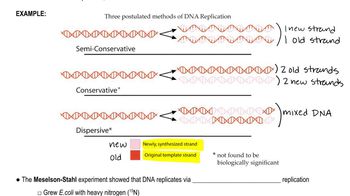Table of contents
- 1. Introduction to Genetics51m
- 2. Mendel's Laws of Inheritance3h 37m
- 3. Extensions to Mendelian Inheritance2h 41m
- 4. Genetic Mapping and Linkage2h 28m
- 5. Genetics of Bacteria and Viruses1h 21m
- 6. Chromosomal Variation1h 48m
- 7. DNA and Chromosome Structure56m
- 8. DNA Replication1h 10m
- 9. Mitosis and Meiosis1h 34m
- 10. Transcription1h 0m
- 11. Translation58m
- 12. Gene Regulation in Prokaryotes1h 19m
- 13. Gene Regulation in Eukaryotes44m
- 14. Genetic Control of Development44m
- 15. Genomes and Genomics1h 50m
- 16. Transposable Elements47m
- 17. Mutation, Repair, and Recombination1h 6m
- 18. Molecular Genetic Tools19m
- 19. Cancer Genetics29m
- 20. Quantitative Genetics1h 26m
- 21. Population Genetics50m
- 22. Evolutionary Genetics29m
8. DNA Replication
Semiconservative Replication
Problem 26
Textbook Question
Assume a hypothetical organism in which DNA replication is conservative. Design an experiment similar to that of Taylor, Woods, and Hughes that will unequivocally establish this fact. Using the format established in Figure 11.5, draw sister chromatids and illustrate the expected results establishing this mode of replication.
 Verified step by step guidance
Verified step by step guidance1
Start by understanding the concept of conservative DNA replication. In conservative replication, the original DNA molecule remains intact, and a completely new copy is made. This means after replication, one DNA molecule is entirely old, and the other is entirely new.
Design an experiment similar to the Taylor, Woods, and Hughes experiment, which used radioactive labeling to track DNA replication. In their experiment, they used tritiated thymidine to label newly synthesized DNA strands.
In your experiment, grow cells of the hypothetical organism in a medium containing a heavy isotope of nitrogen, such as 15N, to label the original DNA strands. Then, transfer the cells to a medium containing a light isotope, 14N, for one round of replication.
After one round of replication, isolate the DNA and use density gradient centrifugation to separate the DNA based on its density. In conservative replication, you would expect to see two distinct bands: one corresponding to the original heavy DNA and one to the newly synthesized light DNA.
Illustrate the expected results by drawing sister chromatids. In conservative replication, after one round of replication, one chromatid will be entirely labeled with the heavy isotope (15N), and the other will be entirely labeled with the light isotope (14N).
Recommended similar problem, with video answer:
 Verified Solution
Verified SolutionThis video solution was recommended by our tutors as helpful for the problem above
Video duration:
2mPlay a video:
Was this helpful?
Key Concepts
Here are the essential concepts you must grasp in order to answer the question correctly.
Conservative DNA Replication
Conservative DNA replication is a theoretical model where the original DNA molecule remains intact, and an entirely new copy is synthesized. This contrasts with semi-conservative replication, where each new DNA molecule consists of one original and one newly synthesized strand. Understanding this model is crucial for designing experiments to test replication mechanisms.
Recommended video:
Guided course

Steps to DNA Replication
Experimental Design in Genetics
Experimental design in genetics involves creating a controlled experiment to test hypotheses about genetic processes. In the context of DNA replication, this includes selecting appropriate organisms, methods for labeling DNA, and techniques for analyzing the results. A well-structured experiment can provide clear evidence supporting or refuting a specific replication model.
Recommended video:
Guided course

Descriptive Genetics
Sister Chromatids and Chromosome Structure
Sister chromatids are identical copies of a chromosome that are connected at a region called the centromere. During cell division, these chromatids separate to ensure each daughter cell receives an identical set of chromosomes. Illustrating sister chromatids is essential for visualizing the outcomes of DNA replication experiments and understanding how different replication models affect chromosome structure.
Recommended video:
Guided course

Chromosome Structure

 14:31m
14:31mWatch next
Master Semiconservative Replication with a bite sized video explanation from Kylia Goodner
Start learningRelated Videos
Related Practice


